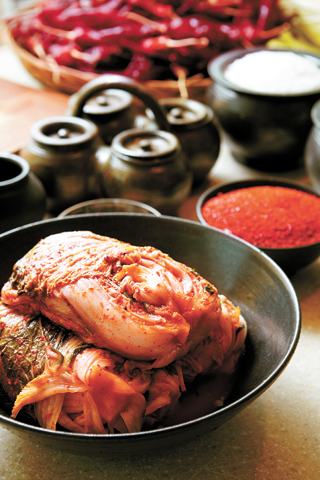![Kimchi is made by fermenting vegetables, particularly cabbage. [Korea Daily File Photo]](http://www.jstudentboard.com/reporter/wp-content/uploads/2014/11/JSR_Nov15_Kimchi-200x300.jpg)
Kimchi is a well-known Korean side-dish eaten with every meal in Korea: breakfast, lunch, and dinner. However, encountering it for the first time can be difficult because of its spicy taste and because of the fact that it is bright red and shriveled. Some people call it a “wrinkly, old grandma” or a “devilish monster,” and culinaryschools.org even listed it among the top ten “most disgusting foods in the world.”
Though Japan and China each have versions of kimchi, my jaw dropped when I first saw a Caucasian person open her mouth wide to fit a lettuce wrap filled with rice, beef, and kimchi. It was especially shocking when my best friend, sitting next to me, ate her salad with kimchi at the dining hall in our school.
“When I first tried kimchi, I didn’t like it,” said Andy Gaylord, the director of dining services at The Madeira School, in an interview with JSR.
However, he continued, “I have since started to enjoy it from a vendor in my local farmer’s market. It is certainly an acquired taste for most Westerners.”
As more and more students of Asian descent have joined schools in the United States, there has been a spread of culture. According to Mr. Gaylord, the original reason for serving kimchi was the demand for kimchi from the South Korean students. Then, westerners grew to love the taste of the side dish and demanded more of it.
Now, Gaylord told JSR, “students and teachers eat kimchi. It never lasts very long on the salad bar.”
For now, though, serving kimchi does have a few drawbacks.
Mr. Gaylord explained, “I would love to serve kimchi all the time… I am responsible for all 300 students and I don’t want to get anyone sick. Kimchi, as you know, deals with live bacteria and requires special handling and preservation. It’s difficult to tell, on the surface, when it has gone bad. Most of my vendors don’t carry it, or if they do it’s in small jars and very expensive.”
The spread of kimchi and other dishes like dried seaweed shows the increased cultural influence Korea has on the world. In the past, my peers had difficulty pinpointing South Korea on a map. Now, however, people know of famous Kpop idol groups and they enjoy numerous delicacies from Korea. Slowly, people of different races are accepting new cultures and opening up to change.

